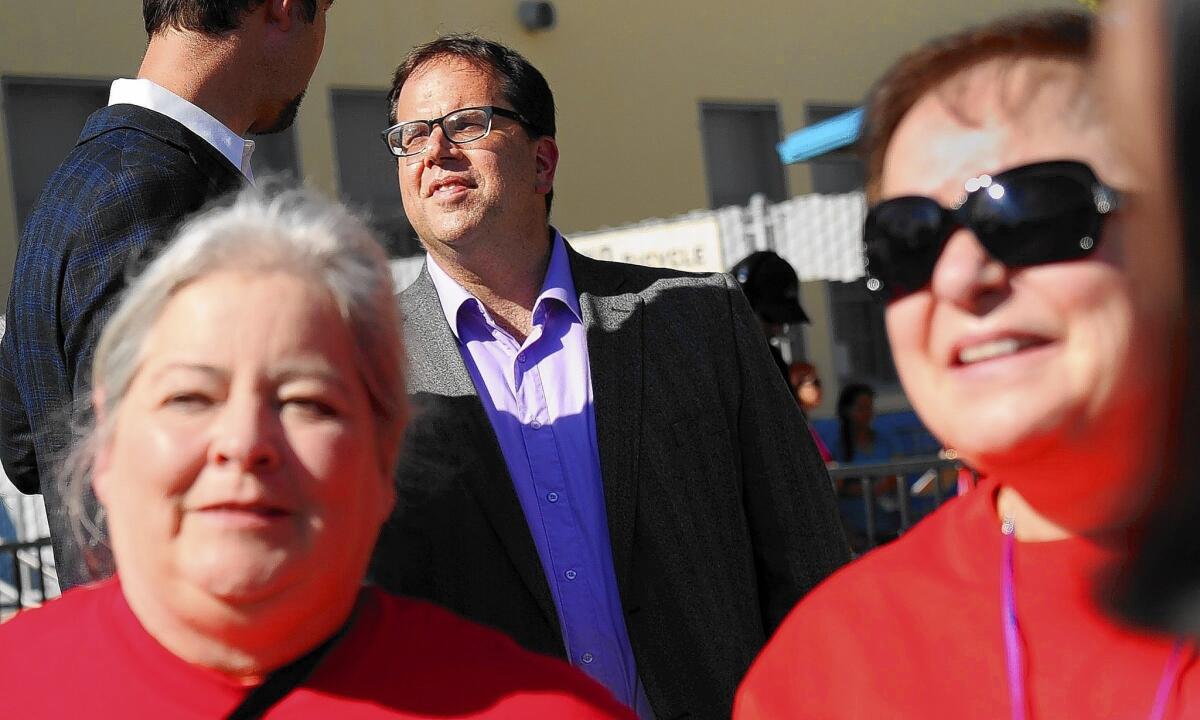L.A. Unified teachers decry new student tracking system

- Share via
Los Angeles Unified spent about $112 million on an online student tracking program a decade ago but dumped it two years ago in favor of another one that promised a streamlined way to manage enrollment, attendance and grades for the nation’s second-largest school district.
The new $20-million system faltered at some campuses just as the school year opened last week, prompting cries from teachers of packed classrooms, vagabond students wandering the halls and a lack of accountability for what went wrong.
Meanwhile, the school district says problems have been solved and that the system mostly is working.
United Teachers Los Angeles, the teachers union, has used the bungled rollout as a rallying cry and an opportunity to sharply condemn Supt. John Deasy.
UTLA has consistently criticized the district since the first day of school, likening the problems to that of the $1-billion iPad rollout, which also was beset by challenges and controversy at the start.
The issues with the computer database, known as the My Integrated Student Information System (MISIS), came as the union launched a campaign Wednesday calling for smaller class sizes, higher staffing levels and raises for teachers amid contentious contract negotiations with L.A. Unified.
L.A. Unified officials contend that the union is simply exaggerating the issues to score political points.
Teachers have described a litany of problems with the database. Some classes had more than 70 students enrolled. Rosters were missing or inaccurate. Students were without class schedules. Some instructors were forced to return to the old days and take attendance by hand.
“From the Valley to the Harbor, it’s been nothing short of a nightmare,” said Colleen Schwab, a UTLA vice president. “It’s frankly unbelievable that this was allowed to be rolled out and affect so many students. It’s a disaster.”
Jay Gehringer, a computer science teacher at North Hollywood High School, also serves as the campus technology coordinator and has been assisting his colleagues in trying to navigate around the problems. Issues with the system were first evident during summer school, when report cards could not be printed and counselors had difficulty enrolling students, Gehringer said.
Once the school year began, it slowed to a halt. “You largely couldn’t do anything in the system,” he said.
Counselors could not access records to make sure students enrolled in the right classes to graduate. About 100 students without schedules were stranded in the cafeteria.
“There aren’t enough directions, there wasn’t enough training, the software doesn’t work as advertised, and there are too many missing features right now,” Gehringer said. “We just don’t have the information to manage the school.”
The information system was required as part of a settlement in a class-action lawsuit that families of special education students brought against L.A. Unified in 1996. Among other issues, the district admitted to losing the records of a student, causing her to repeat 10th grade three times. As a result, L.A. Unified has been under federal court oversight in the years since.
Ron Chandler, the district chief information officer, said that with a massive undertaking such as this, some stumbles are to be expected.
“We do have issues, but the system is working and getting better every day,” Chandler said. “This is going to be a blip we’re going to get through.”
Chandler said while the database has been slow for users, about 99% of students are now in the system and in class — a figure union officials strongly contest.
The district spent about $112 million developing another system with an outside vendor but it did not include all the features the district needed. In 2012, the district broke from the vendor and developed the software that is now in use. The previous version would have cost the district initially about $1.8 million with a 5% increase annually for maintenance.
Parents across the district will now be able to view and monitor their children’s grades and attendance online, Chandler said.
“We’re going to a better place with these systems and we knew that there would be a learning curve,” he said.
UTLA President Alex Caputo-Pearl addressed the issue at a news conference Wednesday at Palms Elementary school, where he announced a “school blitz” in which union officials will visit more than 400 campuses to discuss their negotiation demands with the district.
Caputo-Pearl bristled at the suggestion that union members were overstating problems with the system for political purposes.
“We’re not exaggerating anything,” he said. “We don’t have anything to gain from exaggerating — we want the problem fixed.”
At the request of Los Angeles Board of Education member Tamar Galatzan, the district’s inspector general has begun an audit of the system’s rollout.
[email protected]
Twitter: @stephenceasar
More to Read
Sign up for Essential California
The most important California stories and recommendations in your inbox every morning.
You may occasionally receive promotional content from the Los Angeles Times.











